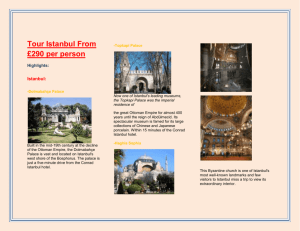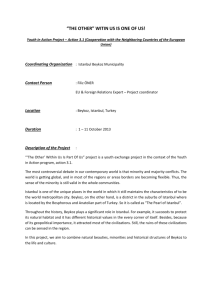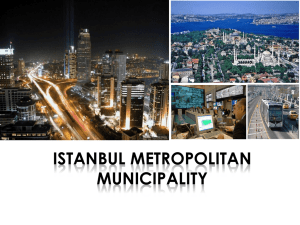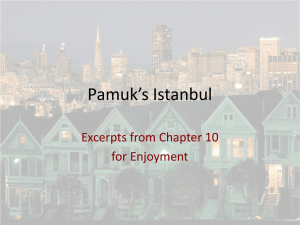Tour-Istanbul-OPEN1
advertisement
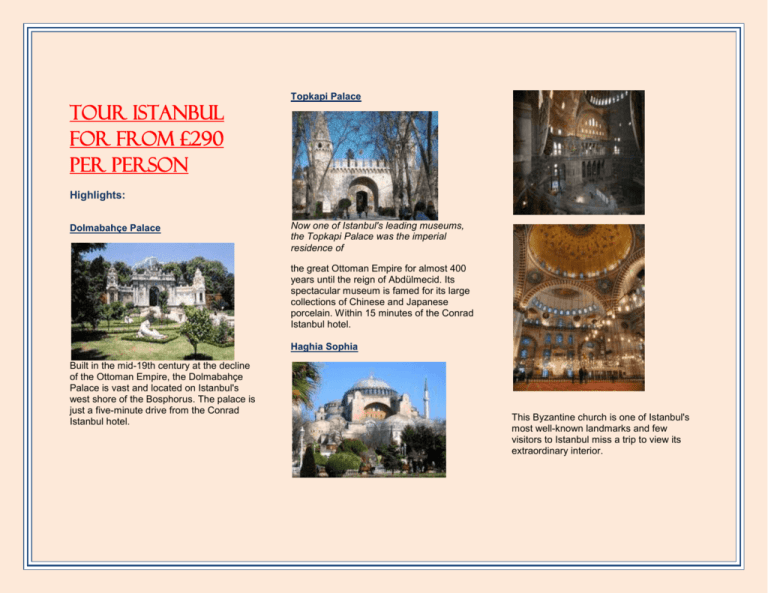
Tour Istanbul for FROM £290 per person Topkapi Palace Highlights: Dolmabahçe Palace Now one of Istanbul's leading museums, the Topkapi Palace was the imperial residence of the great Ottoman Empire for almost 400 years until the reign of Abdülmecid. Its spectacular museum is famed for its large collections of Chinese and Japanese porcelain. Within 15 minutes of the Conrad Istanbul hotel. Haghia Sophia Built in the mid-19th century at the decline of the Ottoman Empire, the Dolmabahçe Palace is vast and located on Istanbul's west shore of the Bosphorus. The palace is just a five-minute drive from the Conrad Istanbul hotel. This Byzantine church is one of Istanbul's most well-known landmarks and few visitors to Istanbul miss a trip to view its extraordinary interior. Blue Mosque Within 15 minutes of the Conrad Istanbul hotel. Prophet Yusa’ Tomb & Mosque Beyond the conspicuous palace of Mohammed Ali Pasa and the mouth of the Hünkâr Iskelesi Valley are the promontory of Selvi Burun and the little Bay of Umur Yeri. Dating from the 17th century, this is one of the largest mosques in Istanbul and is one of the principal features on Istanbul's skyline. On the east side of the mosque is the Arasta, a bazaar for the various tradesman's guilds. Within 15 minutes of the Conrad Istanbul hotel. Yuşa Tomb There is summit of the hill situated a giant symbolic grave which is called "the grave of Yuşa." The Turkish Muslims has declared it the grave of Jesus Navin (Muslim Saint called Yuşa). Grand Bazaar (Kapali Carsi) Joshua's Hill (Turkish:Yuşa Tepesi) the hill which culminates the height of 180-195 meters above sea level and located to the south of Yoros Castle, on the Asian shore of the Bosporus. At the summit of the hill is a terrace with benches for rest of pilgrims, the mosque and tomb of the saint Yuşa. A vast labyrinth of little streets lined with over 4000 shops selling rugs, pottery, jewellery and countless other goodies. important landmark for vessels coming from the Black Sea. The road passes behind the palace of Mohammed Ali Paşa along the wooded and well-watered Valley of Hünkâr Iskelesi, once a favored estate of the Byzantine Emperors and Sultans. On the summit of the hill is a mosque, with the "Giant's Grave" and a *view extending over the whole of the Bosporus (though Istanbul itself is concealed) and part of the Black Sea. Yusa Tepesi (Joshua's Hill), known to the Europeans as the Giant's Grave, an A flat, rectangular earthen rise 17 meters long and 2 meters wide. It is surrounded with a high cast-iron grate, enclosed by means of an iron netting. The point is that the local inhabitants consider the grave miraculous and come here in order to be healed of their illnesses. But, the iron netting doesn't allow the pilgrim to touch the holy ground inside the fence. The ground is overgrown with thick grass. Several high trees grow. At the opposite end of the grave are two circular cylindrical stones, which are reminiscent of small millstones. In the center of one of them are seen a quadrangular opening and a very noticeable fissure. All this is enclosed by a stone wall, in which two doors and several windows have been made. The pilgrims enter one of the doors, pass around the grave in a circle and exit outside through a second door. Buyuk Camlica healthful walk or by a taxi to see the eyecatching rewarding views of Bosphorus and the Shore of the European. Camlica is a place for the pines that’s why this place has been the topic of many poems and songs over the entire years. The Companions in Istanbul & Abu Ayub Al-Ansari Tomb Abu Ayyub al-Ansari still beckons thousands of people. Farmers from Anatolia, businessmen, statesmen, intellectuals, students, women from the countryside in their colorful local dress and foreigners all come to pay their respect, to recite verses of the Quran, to ask for the Creator’s blessing or simply to breathe the spiritual air radiating from area. For many people who come to visit İstanbul for whatever reason, Eyüp is a must see. The outer and inner walls of the tomb are adorned with tiles. The single-domed tomb has an octagonal shape. That part of the tomb housing Abu Ayyub al-Ansari’s sarcophagus, enclosed in silver with beautifully adorned railings, is separated from the rest of the hall. The velvet curtains at the tomb are said to have been originally made for the shrine of the Prophet Mohammed, known as Rawdat-ulMutahhara (Dome of the Prophet); nevertheless the curtains could not be sent there due to the outbreak of World War I and were hung in Abu Ayyub al-Ansari’s tomb instead. Buyuk Camlica is one of the fashionable places for relaxation and recreation. It is one of the oldest venues to boardwalk in Istanbul and was utilized as a vacation points of the Ottoman sultans for the reason that Camlica outlook the entire city from above. This place allows you to appreciate the beauty of the city while chipping in with companion in social activities offered here in Camlica. Buyuk Camlica is located on the largest hill of Camlica where there are lots of cafeterias for you to enjoy your thirst quencher favorite drinks. Buyuk Camlica is a socalled Big Camlica. The visitors can take a including Ottoman sultans, throughout its history. Today, it remains the district’s nucleus and holds a special place in people’s hearts. The tomb of Abu Ayyub al-Ansari (Eyüp Sultan Türbesi) has always been a center of attraction, drawing a variety of people, The mausoleum hall and the tomb chamber have been adorned with calligraphy, crystal chandeliers and silver decorations from different centuries. Furthermore, a footprint of the Prophet Mohammed in marble stone and framed in silver lays embedded in the wall that faces the direction of prayer. GRAVES of twenty-nine Sahaba (companions of the Holy Prophet, in Istanbul are regarded as one of the sacred places to visit. All the Sahaba came here, centuries ago, with the mission of spreading Islam through the means of jihad (action against infidels). After reaching this area, Constantinople, they breathed their last on the land, away from their kith and kin. Very little is known about the lives of those buried here; some of them are barely known by names. According to the Research Centre for the Islamic History, Art and Culture, in Istanbul, the bulk of information provided about their lives is through a major booklet by a Turkish writer: Professor Dr A. Suheyl Unver’s Istanbulda Sahaba Kabirleri (The Graves of the Sahaba in Istanbul), and few notes written about them in Turkish. According to the sources, many of them reached the area along the Muslim troops during the great siege. Many of them were, as the tomb stones show the brief history of their lives, martyred during the siege of Constantinople (Istanbul), and battles fought for the conquest of the city, then a strong hold of the Roman Empire. The graves of Sahaba are spread all over Istanbul. But a majority of them are situated close to the area of Eyub Sultan and Avansarayi. Of the well-known ones that are here, Hazrat Ayub (in Turkish spelled as Eyub) Ansari who hosted Prophet Muhammad (Peace be upon him) in his house after the migration to Medina; Hazrat Abu Zer Ghafari; Jabir bin Abdullah, and Seyhbeth Hudri, a foster brother of the Holy Prophet, Hazrat Hudri, Hazrat Hamidullah and others. According to the Research Centre for Islamic History, Culture and Art in Istanbul, the number of Sahaba who had reached for jihad must have been higher. Nonetheless, the graves of the ones present have traditionally been traced from generation to generation; all revered with respect from one generation to another. The graves have existed since then without being desecrated or demolished during the different periods of rule over Istanbul. The Ottoman Sultans are believed to have respected the graves by visiting them frequently. It was during their time that an effort was made to renovate a number of these graves, which failed. As a tradition says about the grave of a Sahaba, no matter in which corner of the world, it remains in quite simplicity and tranquillity. It is true about the ones in Istanbul. Even the tomb of Hazrat Ayub Ansari, a great companion of the Holy Prophet, in a small room in the corner of a huge splendid mosque, appears very modest. The graves of Sahaba have been the sites of frequent visits by people. One can see people of all ages visiting them with respect. The year of the birth of the Sahaba is not known, neither is their death, except in the case of a few on whose tombstones is it mentioned. The tombstones mention them very briefly and inadequately. However, a fact remains that they reached the area after the death of the Holy Prophet, mostly from 36 to 64 Hijri. A few of them were very old during the time they reached Constantinople. They reached the area when Istanbul was under the Roman rule. Based on the available sources in the Research Centre, and the ones mentioned on the epitaphs, the following is the list of their names and address (location) of the Sahaba. It includes a short-life sketch of some of them. * Hazrat Eyub (Ayub) Ensari’s (for Ansari in Turkish) shrine exists in the courtyard of Sultan Eyub Camii (Mosque), Sultan Eyub area. His shrine is a famous pilgrimage place for people all over Turkey and other parts of the world, particularly the Islamic countries. The entrance to the shrine is from inside the mosque with an exit outside. Outside the shrine is a marble table outlining the short life sketch of Hazrat Ayub. The shrine is believed to have been venerated by Byzentines long before the Ottoman rule was established in Istanbul. The mosque, inside the shrine exists, is one of the oldest and historical mosques the Ottomans built in Istanbul. The shrine is open to visit from 9.00 in morning to 5pm. The area where shrine exists is a busy centre of the city and buses reach the area from each corner of the city. 697AD. * Hazrat Abu Derda, Zalmahmudpsha Caddesi (street), in Eyub Sultan area. (it is in few minute walking distance to the shrine of Hazrat Ayub). No date of his death is available. * Hazrat Edhem (Ahdem), Abdurrahman Sherf Bey Caddesi, Nishanca Mahalah in Eyub Sultan. According to traditional sources he died in 46AH. * Hazrat Hayreddin (Khariddin) Arab, Arpaci Hayreddin Sokak (sub-street) in Nishanca Mahalah in Eyub Sultan. * Hazrt Kaab, inside Yavedud Camii in Avansaray just outside the rampart wall. * Hazrat Muhammad el Ensari’s shrine is on main Avansaray caddesi in Avansaray. * Hazrat Jabir bin Semure or Jabir bin Abdullah is buried inside a small old mosque named after him as “Jabir Camii” in the Avansaray. His father was Abdullah bin Amr. Hazrat Jabir is a famous warrior Shahbi who participated in all battles alongside the Holy Prophet. As mentioned on the introductory tablet about his short life sketch, he was born 16 years before the Hijrat. As a great warrior he participated in a total of 19 battles, including of Badr and Uhad. He served as an adviser to the four Caliphs on war matters. Soon after the martyrdom of Hazrat Ali he moved to Syria. Later on, he is believed to have migrated to (Constantinople). As the record shows he was martyred in a battle in Istanbul in * Hazrat Abu Zer Ghaffari is buried in a remote corner of a small mosque, named after him, on the Cinarlicesme Sokak inside the Avansaray. As engraved on a stone tablet outside the tomb, his original name was Jundeb. He was the fifth person to embrace Islam. The name Abu Zer was given to him by the Holy Prophet. Because of his belonging to Ghaffari tribe, he was known as Ghaffari. He died in 32AH. He is believed to have travelled to Istanbul from Syria where he lived many years after his departure from Medina during the reign of Hazrat Usman. An iron-cage surrounds his tomb. * Abu Seybeti (Shahbat) Hudri, on Ibrahim Dede Sokak in Avansaray. As shown on the introductory plate on top of the tomb, the Sahaba is also the foster brother of the Holy Prophet. Abu Seybeti died in 74AH. * Hazrat S’ube, on Sishane Caddesi in Avansaray (the tomb is in closer distance to Egri gate (the existence is inside the compound of a house. One can enter inside the compound upon the permission of the dwellers. * Hazrat Abdullah il Hudri’s grave is in few yards distance in the rear of the Karlye museum in Edirnekapi. The record available about his life shows that he entered Istanbul with Islamic troops at the age of 15. He participated in all battles fought against Romans. He died in 666AD. The Karlye Museum, is one of the oldest churches in Istanbul, now turned into museum. One can see a large number of visitors to the museum everyday. * Hazrat Husam bin Abdullah, on Salmatomruk Pashamam Caddesi in Egrikapi (closer to Edirnekapi area). * Hazrat Ahmed el Ensari is buried in the Ibrahim Sokak in the Avansaray. He entered Istanbul along with Hazrat Ayub. * Hazrat Abdullah Ansari is buried on the Salmatomruk Pashamam Caddesi in Edirnekapi. * Hazrat Ahmed el Hudri is buried on the Kandill turbe Sokak inside the Egri gate of the rampart wall in Avansary. * Hazrat Hassan and Husayin, the two brothers are buried in Salmatomruk Pashamam, Hassan huseyin yokusu (downhill). The graves are surrounded by a compound built with an entrance. They are believed to have reached the area with Hazrat Eyub when very young, and were martyred during the siege of Constantinople. The graves of Hazrat Hudri, Hazrat Husam, Abdullah Ansari and Hassan Husayin are at a closer distance from there. * Hazrat Hafir, outside the Egri gate of the rampart wall of Avansaray. * Hazrat Abdul Sadiq bin Amir, (the same place where is the grave of Hazrat Hafir). An epitaph in Arabic script Turkish, fixed in 1790, is still in existence. It reads only his name as a Sahaba. horn. * Hazrat War bin Abdullah’s grave exists near Hoca Kasim Camii. * Hazrat Abdur Rehman Pasha, on Kaleboyu Sokak, Edirnekapi Hazrat (just under the rampart wall). * Hazrat Hazrat Abdul Rehman Sami, Sultanahmed on Kabasakal Sokak (near the Yesil Ev hotel). The grave is at 30 yard distance from the main gate of the Topkapi Palace. The tombstone on the shrine say that he reached the area in 48AH, and died few years after. * Hazrat Abdul Rauf Samdani, in front of the grave of Hazrat Baba Jaffar. * Hazrat Sufyan ibni Ubeyne, inside the Yeralti Camii in Karakoy. * Hazrat Wahab, inside the same mosque (Yeralti Camii). * Hazrat Amr ibni As, Yeralti Camii in Karakoy (Hazrat Amr and Hazrat Veheb buried side by side in the same room). * Hazrat Mesleme bin Abdul Malik is buried outside in the yard of the Arab Camii in Karakoy. The mosque is also one of the oldest mosques of the city. * Hazrat Abu Derda, in a graveyard near the shrine of Sultan Karaca Ahmed (the place is known after him as Karacahmed, named after a Turk sufi who lived in the Uskudar). The Uskudar area falls in the Asian side of Istanbul across the Marmara Sultan Muhammad Fatih II The Conqueror & Fatih Mosque The Holy Hadith/Tradition of Muhammad sallallahu alaihi wa sallam peace be upon him: 'Verily you shall conquer Constantinople. What a wonderful commander will that commander be, and what a wonderful army will that army be!' In 1453, the 7th Sultan of the Ottoman Empire, Sultan Muhammad / Mehmed II the Conqueror, radiyAlahu anh, finally conquered Constantinople, a city dreamed of by many kings, emperors and sultans. The conquest of Istanbul, which became the new capital of the Ottoman Empire, was an important turning point in world history: Miniaturk, Istanbul abroad to place an order with the artists who created Miniaturk. Whether you take a traditional Istanbul ferryboat, or a faster TurYol boat, you're sure to enjoy a tour-cruise up the Bosphorus. You can do it in as little as 1.5 hours. Bosphorus Cruise, Istanbul You set out from the Eminönü ferryboat docks (on the Golden Horn between Galata Bridge and Sirkeci Station) and head north toward the Black Sea. (More...) As of early spring 2003 it is possible to find a miniature version of the historic sites of İstanbul, Anatolia and former Ottoman provinces in one spot in Istanbul, namely Miniatürk. Coupled with the distinction of being most rapidly completed miniature park in the world, it boasts of a record number of visitors since it opened in March. Located along the nostalgic Golden Horn, Minitürk is expected to contribute to the rehabilitation of the historic neighborhood in which it sprawls across an area of 60 thousand square meters, larger than any other miniature city in the world. The exhibition area itself is 15 thousand square meters. The concept of Miniaturk was inspired by Moduradam in the Netherlands, one of the earliest miniature parks dating from 1952. Moduradam became so impressed by its Turkish counterpart that it suspended its policy of not commissioning models from Here are the sights you'll see (including six Ottoman palaces), divided into two parts, the Southern Bosphorus (from the Golden Horn and city center to the Bosphorus Bridge) and the Northern Bosphorus, (from the Bosphorus Bridge to the Black Sea): Southern Bosphorus The most impressive sights are along the southern shores of the Bosphorus, nearest to the city: Topkapi Palace, the midBosphorus Maiden's Tower, the Selimiye Barracks (where Florence Nightingale worked), Dolmabahçe Palace, Çiragan Palace, Yildiz Park & Palace, the chic artboutique-and-cafe scene in the village of Ortaköy, the pretty Ottoman baroque Mecidiye Mosque, and the Bosphorus Bridge. More... Northern Bosphorus Beyond the Bosphorus Bridge there's plenty more to see: Beylerbeyi Palace, the village of Çengelköy, Kuleli Naval Academy, Arnavutköy with its photogenic Ottoman yalis (wooden Bosphorus seaside mansions), Rumeli Hisari (the mighty Fortress of Europe), the town of Bebek with its pretty bay, and Bosphorus University. If you take the traditional ferry's Bosphorus tour all the way to the end, you will have to wait three hours at the northern terminus of Anadolu Kavagi for the ferry's departure for the return to Istanbul. But you can get off the boat in Sariyer, have lunch, then ride south along the shore. North of the Fatih Bridge, second to be built across the Bosphorus, is Anadolu Hisari (the Fortress of Anatolia), Küçüksu Kasri (a fine little rococo palace), the Hidiv Kasri (fine Art Nouveau villa (1900) of the Khedive of Egypt), the pretty restaurant village of Tarabya, the town of Büyükdere (with its excellent Sadberk Hanim Museum), Sariyer (with a fish market and several seafood restaurants on the shore). You should know that Backpackers Travel operates a great value-for-money half-day tour that takes you on the TurYol Bosphorus cruise and also visits the Egyptian (Spice) Bazaar, the Galata Tower, Tünel, Galata Bridge, and Karaköy (Galata) Square all in one afternoon for a very good price. More... Rumeli Kavagi (the farthest northern dock on the European shore of the Bosphorus), and Anadolu Kavagi (the final dock on the Bosphorus cruise-tour) are about 10 km (6 miles) south of the Black Sea, but these docks are as far as the Bosphorus cruises go. If you take the TurYol boat, you'll be back at the Galata Bridge in less than an hour. Here's how to tour the European shore of the Bosphorus by road from Sariyer to Istanbul, and here's an hour-by-hour itinerary to hit the main sights.


